Take a trip of a lifetime when you travel along the North Coast 500, Scotland's very own Route 66. As far as we're concerned, this touring trail is one of the most spectacular ways to take in all the Northern Highlands offers.
What is the North Coast 500?
One route, 500+ miles (516 if we're being precise!), and an abundance of stunning views, gorgeous landscapes, beautiful beaches and mountain ranges are just waiting to be discovered. However, you may not realise that the North Coast 500 can also claim to have a fair few castles under its belt. Join us today as we explore 10 of them. The castles have been listed alphabetically to avoid any bias!
Castles in the Scottish Highlands
Ardvreck Castle
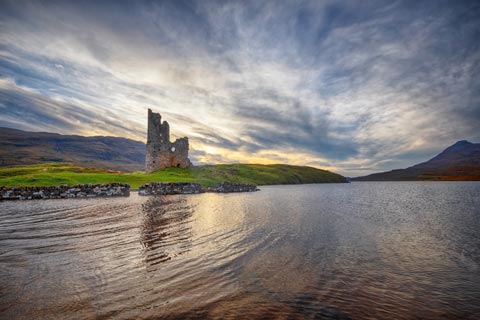
Ardvreck Castle has existed since 1490 and is associated with the Macleods of Assynt. Its history includes betrayal, deceit, and death.
With a remote location, these picturesque ruins sit on the shores of Loch Assynt.
In 1650, the Marquess of Montrose found himself at the castle following his defeat at the Battle of Carbisdale, but he didn't realise that things were about to get a lot worse. The wife of Neil Macleod, Christine, deceived him, and he found himself imprisoned in the dungeon. Christine alerted the Government, which resulted in his capture, his transportation to Edinburgh and his eventual execution.
Bucholie Castle
Disclaimer: Our research returned three different iterations of the spelling of this castle – Bucholie, Buchollie and even Bucholly Castle! And to add an extra layer of confusion, this castle used to be called Lambaborg. However, we will use the Bucholie Castle version for this article (and to save on any further confusion)!
Thought to be built by a Norse pirate no less than at the start of the 12th century, what really makes this castle stand out is the rather dramatic way you enter this castle… with extreme caution! This is because there are significant drops on either side of the entryway.
Unfortunately, Bucholie Castle is now in a bad state of repair and has been since the 17th century after it was sold to the Sinclairs.
Carbisdale Castle
A more modern castle having been built at the start of the 20th century for the Dowager Duchess of Sutherland, Carbisdale Castle is set within a 2000-acre forest, aptly called Carbisdale Forest… and even boasts its very own loch.
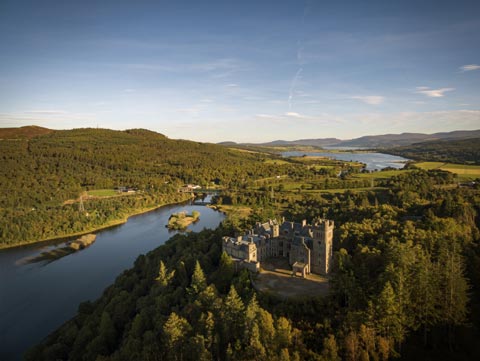
Carbisdale Castle was eventually bought a couple of decades later in 1933 by the Christian Salvesen Dynasty (Norwegian head) and ended up playing a role in offering shelter during the Second World War before changing hands again in 1945 when it was given to the Scottish Youth Hostels Association.
Spooky Castle
This decision cost the castle – literally. The upkeep proved too challenging, and eventually, it was sold to Lady Samantha Kane of Carbisdale, who now uses Carbisdale Castle in a private capacity.
Fast forward to today, and any keen ghost hunter may be interested to know that the castle has its very own "Spook Room", where sightings have been reported. Spooktacular!
Dunrobin Castle and Gardens
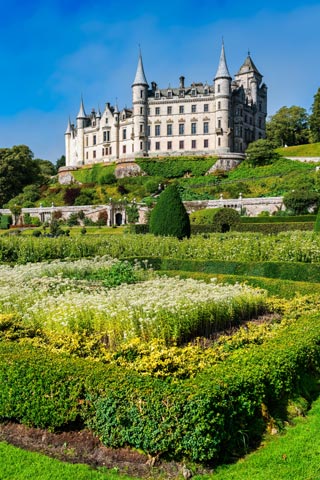
Arguably one of the most popular and well-known Scottish castles, Dunrobin Castle is also the biggest, boasting an impressive 189 rooms, many with breathtaking views. With a Gaelic-derived name, Dun Robin (translating to Robin's Hill or Fort), it has also been lived in for several decades, dating back to the 14th century, being called home by the Earls and Dukes of Sutherland.
Boarding School
As if that wasn't enough, Dunrobin Castle also has a colourful past. It was used as a Naval Hospital during the First World War and a boarding school for boys from 1965 for almost a decade.
From an architectural point of view, it has had input from both Sir Charles Barry (of Houses of Parliament designer fame!) and Sir Robert Lorimer.
It was not too bad for an originally fortified square keep whose most impressive features could only include walls that were 6 feet thick and an arched ceiling!
Inverness Castle
Inverness is often considered the Capital of the Highlands, so it's only fitting that this city also has its own castle.
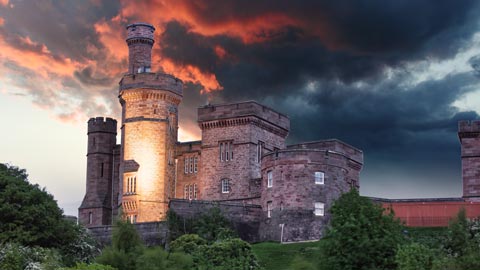
You'll find Inverness Castle sitting alongside the River Ness on the aptly named Castle Hill, having started life as a medieval fortification, undergoing several iterations over the years. It was set on fire by the MacDonalds and then destroyed during the Battle of Culloden by the Jacobites during the 18th century.
Flora MacDonald
It was also the location of a courthouse and prison, and the statue of Flora MacDonald calls Inverness Castle her home.
More recently, a landslip in 1932 resulted in a wall collapse, causing damage to the general area (although, luckily, nobody was hurt). The remaining land gradient provides evidence of this landslip to this day.
Inverness Castle has a rich history that is worthy of an entire blog. Although we don't have time to mention it all here, if you're interested, we highly recommend you do your own research if you have time (or why not book yourself on one of our relevant tours, such as our Skye, The Highlands and Inverness tour) to find out more?
Castle of Mey
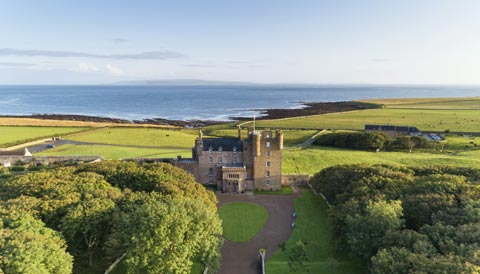
If you're looking for a castle with a bloody and Royal history… you've found it!
The Castle of Mey was built by the 4th Earl of Caithness, also known as George Sinclair, for his second son, William. William met a bloody end after he was killed by his elder brother, John, who was in turn then also killed. The castle was then given to George Sinclair, the third son, who luckily survived, resulting in a name change to Barrogill Castle and acting as the seat of the Earls of Caithness for several years.
Fast forward to 1952, when the late Queen Elizabeth, The Queen Mother, purchased the castle. Following renovations and the development of its beautiful gardens, she called it the Castle of Mey once more. It can even count King Charles (before he became King) among its many visitors.
Castle of Old Wick
When it comes to the Castle of Old Wick, its origins are not known for certain. However, some theories have been put forward. The first concerns Earl Harald Maddadson during the 1100s. It was said that Sir Harald built the Castle of Old Wick, although an alternative theory concerns the building taking place centuries later, during the 14th century.
Both the Sutherland and Oliphant families have ties to this castle, and similarly to many of the other castles we've looked at, the Castle of Old Wick now also sadly lies in ruins. Furthermore, the Castle of Old Wick is described as being in an "advanced state of ruin" by Historic Environment Scotland. Yet, remarkably, you can still make out some of the original features. Keep an eye out for that fireplace on the second floor!
Castle Sinclair Girnigoe
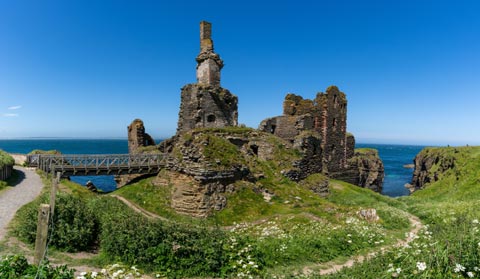
The ruins of this castle were so impressive that it had to be named twice! It was said that Castle Sinclair Girnigoe was comprised of 2 ruins, those of Castle Girnigoe from the 15th century and those from Castle Sinclair from the 17th century. However, more recently, it has been said that it was actually just one castle, built during the middle of the 15th century, thanks to archaeological and research finds.
Regardless of whether the ruins are from 1 or 2 castles, they were lived in by the Earls of Caithness until the death of George Sinclair and John Campbell of Glen Orchy took over. Eventually, the castle was destroyed towards the end of the 17th century.
Currently, the Clan Sinclair Trust is responsible for protecting Castle Sinclair Girnigoe. It is also worth noting that this is the only castle listed by the World Monuments Fund.
Skelbo Castle
You can't think of Skelbo Castle without thinking of Loch Fleet. This is because this castle would have been involved in the crossings over the loch (it also offers fabulous views over said loch)!
Skelbo Castle was also involved in quite a few transactions when it came to ownership. Going back to the 13th century and the Thane of Sutherland, you have the land being given to Gilbert de Moravia, who then transferred it to his brother, Sir Richard, following his taking on the title of the Bishop of Caithness.
Eventually, ownership by the Moravia family was taken over by the Kynnards (through marriage), followed by the Earl of Sutherland. That's quite a list! Another castle to keep an eye out for when you're touring the North Coast 500.
Strome Castle
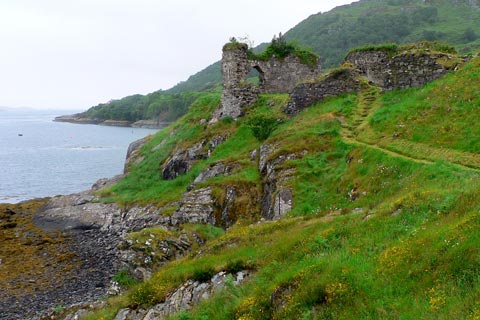
We end our tour of castles to be found on the North Coast 500 with Strome Castle, which was fought over by two rival clans, the Mackenzies and the MacDonalds. With one clan being given possession followed by the other, events finally came to a head in 1602 when Kenneth Mackenzie successfully took the castle… in the unlikeliest way.
The Macdonald women were collecting water from the well but erroneously poured their haul into the castle buckets containing gunpowder, resulting in a fight. A prisoner from the Mackenzie clan heard what was happening and ended up telling Kenneth… who realised that meant the castle had no way of defending itself.
The Macdonalds surrendered and left Strome Castle, after which it was destroyed. The remains of the castle following this destruction can be seen in the present day.
Explore Scotland's castles with Scottish Tours
As we end our exploration of 10 of the castles on the North Coast 500, we hope we've convinced you that the North Coast 500 is a trip you must take when you visit Scotland.
If you want to ensure you take in all the highlights of the North Coast 500, why not take our Skye, Orkney and the North Coast 500 tour?
Browse available tours and book online today.
Picture credits: Shutterstock, VisitScotland and Wikimedia (Wojsyl)

